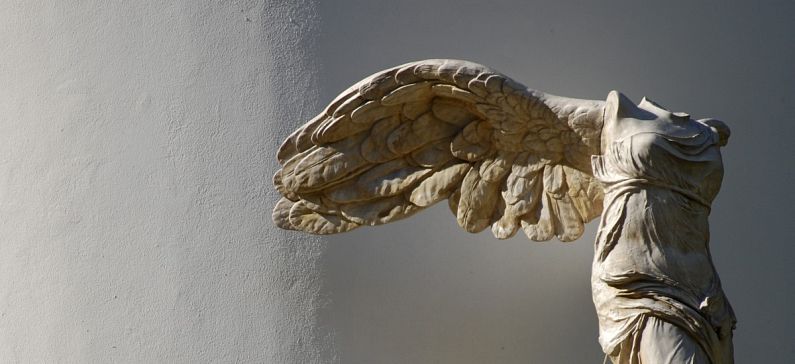
The five most important ancient Greek exhibits abroad
Ancient Greece is a culture compass for all the world. The ancient exhibits attract millions of tourists every year in Greece, but many pieces of ancient Greek art can be found in museums around the world. Ellines.com chose 5 Greek antiquities found in museums abroad that are a tourist attraction and the top exhibits of these museums.
1. The Parthenon Marbles – British Museum
The Parthenon Marbles, a group of sculptures, statues, inscriptions and architectural elements depicting scenes from Greek mythology, were once part of the Parthenon. Built in 5th century BC to honor Athena, the temple has become one of the most recognized symbols of Western culture and is regarded as the highest architectural achievement of the Ancient Greeks.About half of the marbles were torn from the temple between 1801 and 1802 by the Earl of Elgin while Athens was under Ottoman occupation.
2. Aphrodite of Milos – Louvre Museum
The Venus de Milo was discovered in 1820 on the island of Melos (Milo in modern Greek) in the south-western Cyclades. The Marquis de Rivière presented it to Louis XVIII, who donated it to the Louvre the following year. The statue won instant and lasting fame. Essentially two blocks of marble, it is comprised of several parts which were sculpted separately (bust, legs, left arm and foot) then fixed with vertical pegs, a technique which was fairly common in the Greek world (especially in the Cyclades, where this work was produced around 100 BC). The goddess originally wore metal jewelry — bracelet, earrings, and headband — of which only the fixation holes remain. The marble may have been embellished with (now faded) polychromy. The arms were never found.
3. Winged Victory of Samothrace – Louvre Museum
The Winged Victory is one of the five most popular works at the Louvre Museum, which attracts almost 10 million visitors a year.This exceptional monument was unearthed in 1863 on the small island of Samothrace in the northwest Aegean. It was discovered by Charles Champoiseau, French Vice-Consul to Adrianople (Turkey). The goddess of Victory (Nike, in Greek) is shown in the form of a winged woman standing on the prow of a ship, braced against the strong wind blowing through her garments.
Given its importance and its weight, it was the first time since World War II the statue was moved and the first time it was restored since it was installed in the staircase. Restoring old, stained marble is complicated and delicate work. The conservationists cleaned the white marble with compresses soaked in water to protect the old stone and erase the layers of grime. The work on the Winged Victory was made more complex by reconstitutions in the 19th century. When the statue was brought to Paris from the Greek island of Samothrace, near Turkey’s Dardanelles Straits, the statue was broken in several pieces. Museum experts in the late 19th century covered the joints with plaster and painted over it. The restoration team replaced the plaster with a marble-base binder so that no paint would be needed. The Winged Victory originally stood in Samothrace on a cliff towering over the esplanade of the Sanctuary of the Great Gods, a complex of a dozen temples dedicated to different deities popular in Antiquity.
4. The Pergamon Altar – Pergamon Museum Berlin
The Pergamon Altar is a monumental construction built during the reign of King Eumenes II in the first half of the 2nd century BC on one of the terraces of the acropolis of the ancient city of Pergamon in Asia Minor. The structure is 35.64 metres wide and 33.4 metres deep; the front stairway alone is almost 20 metres wide. The base is decorated with a frieze in high relief showing the battle between the Giants and the Olympian gods known as the Gigantomachy.
In 1878, the German engineer Carl Humann began official excavations on the acropolis of Pergamon, an effort that lasted until 1886. The excavation was undertaken in order to rescue the altar friezes and expose the foundation of the edifice. Later, other ancient structures on the acropolis were brought to light. Upon negotiating with the Turkish government (a participant in the excavation), it was agreed that all frieze fragments found at the time would become the property of the Berlin museums.
5. The Harp player – MET
The best-known art of Cycladic Art are the marble figures usually called «idols» or «figurines» and especially known are the harp-player and the pipe-player.
A male figure playing a stringed instrument sits on a high-backed chair. This work is one of the earliest of the small number of known representations of musicians. It is distinguished by the sensitive modeling of the arms and hands.

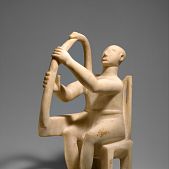
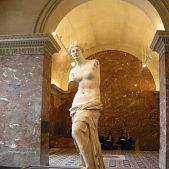
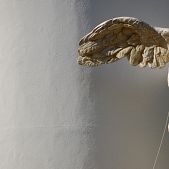
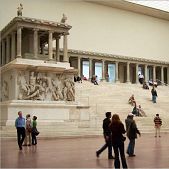
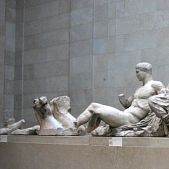







Theofanis Konstadinidis
-25/10/2016 11:05 pm
All the monuments and statues should be
send back to Greece… How they hold
these Greek treasuries if they don’t belong to theme??? Turkey never gave any value to
helenic culture and heritage during Otoman
occupation… a SHAME
Γωγω
-06/03/2018 10:59 pm
Πως γινεται να μισουν την ελλαδα,να μας θεωρουν τεμπεληδες,κλεφτες,λαμογια κτλ,τη στιγμη που εκεινοι εχουν κλεψει την ιστορια μας και την προβαλουν στα μουσεια τους!
Καμια αλλη χωρα δεν εχει αδικηθει τοσο πολυ,οσο η ΕΛΛΑΔΑ